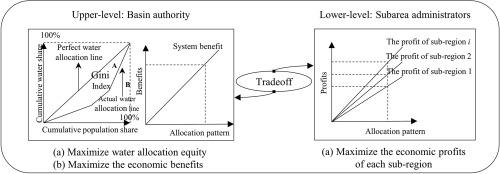Journal of Contaminant Hydrology ( IF 3.6 ) Pub Date : 2021-04-29 , DOI: 10.1016/j.jconhyd.2021.103816 Jun Xiao 1 , Yanpeng Cai 1 , Yanhu He 1 , Yulei Xie 1 , Zhifeng Yang 1

|
In this research, a dual-randomness bi-level interval multi-objective programming (DR-BIMP) model was developed for supporting water resources management among multiple water sectors under complexities and uncertainties. Techniques of bi-level multi-objective programming (BMOP), double-sided stochastic chance-constrained programming (DSCCP), and interval parameter programming (IPP) were incorporated into an integrated modeling framework to achieve comprehensive consideration of the complexities and uncertainties of water resources management systems. The DR-BIMP model can not only effectively deal with the interactive effects between multiple decision-makers in complex water management systems through the bi-level hierarchical strategies, but also can characterize the multiple uncertainties information expressed as interval format and probability density functions. It could thus improve upon the existing bi-level multi-objective programming through addressing discrete interval parameters and dual-randomness problems in optimization processes simultaneously. Then, the developed model was applied to a real-world case to optimally allocate water resources among three different water sectors in five sub-regions in the Dongjiang River basin, south China. The results of the model include determining values, interval values, and stochastic distribution information, which can assist bi-level decision-makers to plan future resources effectively to some extent. After comparing the variations of results, it is found that an increasing probability level can lead to higher system benefits, which is increased from [20,786.00, 26,425.92] × 108 CNY to [22,290.84, 27,492.57] × 108 CNY, while the Gini value is reduced from [0.365, 0.446] to [0.345, 0.405]. A set of increased probability levels gives rise to the lower-level objectives. Furthermore, the advantages of the DR-BIMP model were highlighted by comparing with the other models originated from the developed model. The comparison results indicated that the DR-BIMP model was a valuable tool for generating a range of decision alternatives and thus assists the bi-level decision-makers to identify the desired water resources allocation schemes under multiple scenarios.
中文翻译:

区域水资源管理的双随机双层区间多目标规划模型
在这项研究中,开发了一种双随机性双层区间多目标规划 (DR-BIMP) 模型,用于支持复杂性和不确定性下多个水部门之间的水资源管理。将双层多目标规划(BMOP)、双边随机机会约束规划(DSCP)、区间参数规划(IPP)等技术纳入综合建模框架,实现对水的复杂性和不确定性的综合考虑资源管理系统。DR-BIMP 模型不仅可以通过双层分层策略有效处理复杂水资源管理系统中多个决策者之间的交互作用,而且可以表征以区间格式表示的多个不确定性信息,概率密度函数。因此,它可以通过同时解决优化过程中的离散区间参数和双随机性问题来改进现有的双层多目标规划。然后,将开发的模型应用于实际案例,以优化配置华南东江流域五个子区域三个不同水部门之间的水资源。该模型的结果包括确定值、区间值和随机分布信息,可以在一定程度上帮助双层决策者有效规划未来的资源。比较结果的变化后发现,增加概率水平可以带来更高的系统收益,从 [20,786.00, 26,425.92] × 10 8 增加CNY 到 [22,290.84, 27,492.57] × 10 8 CNY,而基尼系数从 [0.365, 0.446] 减少到 [0.345, 0.405]。一组增加的概率级别会产生较低级别的目标。此外,通过与源自开发模型的其他模型进行比较,突出了 DR-BIMP 模型的优势。比较结果表明,DR-BIMP 模型是生成一系列决策备选方案的宝贵工具,从而帮助双层决策者确定多种情景下所需的水资源分配方案。



























 京公网安备 11010802027423号
京公网安备 11010802027423号